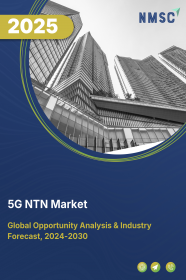
5G NTN Market by Component (Hardware, Software, and Services) by Technology (Satellite-Based, High-Altitude Platform Station (HAPS), and Unmanned Aerial Vehicles (UAVs)), by Application (Natural Language Processing, Enhanced Mobile Broadband (eMBB), Massive Machine-Type Communications (mMTC), and Others), by Location (Urban, Rural, Remote, and Isolated), and by End-User (Aerospace & Defense, Maritime, Government, Mining, and Others) – Global Opportunity Analysis and Industry Forecast 2024-2030
US Tariff Impact on 5G NTN Market
Trump Tariffs Are Reshaping Global Business
5G NTN Market Overview
The global 5G NTN Market size was valued at USD 12.33 billion in 2023 and is predicted to reach USD 100.77 billion by 2030 with a CAGR of 33.5% from 2024-2030.
The 5G non-terrestrial networks (NTN) market refers to the integration of satellite and airborne communication system with terrestrial 5G networks that enhances the global connectivity, especially in remote areas.
The primary advantage of the 5G non-terrestrial network lies in its ability to extend 5G coverage to regions that faces challenges such as isolated rural areas, maritime zones, and high-altitude locations. This expansion supports critical applications including remote sensing, global IoT connectivity, and enhanced emergency response capabilities.
The 5G satellite communication network facilitates inclusive and reliable communications that drives innovation in network designing and service delivery, thereby brining evolution in global communication networks.
Market Dynamics and Trends
The rising internet penetration increases the demand for faster and more reliable connectivity solutions including 5G non-terrestrial network, that in turn propels the growth of the market. This surge fuels the need for NTN technologies such as satellite networks and high-altitude platforms (HAPs), that provides expansive coverage and support seamless connectivity in remote areas.
According to the latest report published by the Organisation for Economic Co-operation and Development (OECD), as of 2023, 91.5% of all households in the world possess internet connectivity.
Consequently, the increasing expansion of internet access globally accelerates the demand for 5G NTN technologies for meeting the growing demand for widespread, and reliable connectivity across all regions.
Moreover, the growing adoption of IoT (Internet of Things) devices is driving the need for high-speed and low-latency connectivity, that in turn propels the 5G NTN market growth. According to the Global System for Mobile Communications (GSMA’s) annual State of Mobile Internet Connectivity Report (SOMIC) 2023, around 4.3 billion people owns a smartphone. This rising adoption of smartphones enhances the need for 5G NTN solutions to efficiently manage network traffic and ensure seamless connectivity across diverse environments, further fueling the market growth.
Additionally, the increasing demand for enhanced rural coverage and connectivity is driving the 5G NTN market expansion, as operators worldwide increasingly adopt these technologies to address the need for widespread, high-quality network access in remote areas.
According to a latest report by the Global mobile Suppliers Association (GSA), 10 operators in 10 countries and territories commercially launched satellite services integrated with 5G non-terrestrial networks technologies. These launches enable operators to provide high-speed, reliable connectivity in regions where traditional terrestrial networks are challenging to deploy. Therefore, such strategic expansion addresses current connectivity challenges and also highlights the essential role of 5G non-terrestrial technologies in improving global internet access.
However, the high costs related to the development and deployment of 5G NTN, including satellite, ground stations, and network equipment, restrain the growth of the market. This financial burden limits the ability of operators, particularly in emerging markets, to invest in and expand these advanced technologies, thereby restraining the growth of the market.
On the contrary, the introduction of low earth orbit (LEO) satellite constellations is expected to create ample future opportunities for the market. These satellite networks enhance coverage, reduce latency, and expand the reach of 5G networks to remote areas worldwide.
For instance, in Feburary 2024, Sateliot partnered with Kongsberg Satellite Services (KSAT) and Amazon Web Services (AWS) to deliver a global end-to-end standard 5G NB-IoT NTN service without needing dedicated ground gateways. Subsequently, such integration will accelerate the deployment of next-generation networks and stimulate innovation in sectors that depend on real-time data, that in turn will significantly boosts the growth of 5G non-terrestrial network market opportunities.
Market Segmentation and Scope of Study
The 5G NTN market report is divided on the basis of component, technology, application, and end user and region. On the basis of component, the market is segmented into hardware, software, and services. On the basis of technology, the market is categorized into satellite-based, high-altitude platform station (HAPS), and unmanned aerial vehicles (UAVs). On the basis of application, the market is segmented into enhanced mobile broadband (eMBB), massive machine-type communications (mMTC), and ultra-reliable low-latency communications (URLLC). On the basis of end user, the market is classified into telecommunications, defense, transportation, agriculture, and others. Regional breakdown and analysis of each of the aforesaid segments includes regions comprising of North America, Europe, Asia-Pacific, and RoW.
Geographical Analysis
Asia-Pacific dominates the 5G NTN market share and is expected to continue its dominance throughout the forecast period. This is attributed to the innovations in satellite technology and enhanced network infrastructure by local and international organisations that are enabling faster and more reliable connectivity including the 5G NTN connectivity.
For instance, in June 2024, Auden launched new solutions for adopting 5G non-terrestrial network in private networks. This solution combines the Auden’s Low Earth Orbit (LEO) satellite user terminal with 5G NR Open RAN radio unit that allows the extension of 5G network coverage and performance to remote locations. Consequently, such strategic innovations in 5G non-terrestrial network by local and international organizations drives the growth of the market in the region.
Moreover, the increasing internet penetration accelerates the demand for high speed, and reliable connectivity, thereby driving the 5G NTN market demand. According to a report published by the International Telecommunication Union (ITU) as of 2023, around 66% of the total population in Asia-Pacific uses internet connectivity. This surge in the growth of internet connectivity necessitates advancements in network infrastructure, with 5G NTN infrastructure emerging as a key solution to bridge connectivity gaps, especially in remote areas. Thus, the rise in internet usage across the region highlights the crucial need for enhanced network infrastructure, positioning 5G non-terrestrial networks as a pivotal advancement to ensure comprehensive and reliable connectivity in the region.
On the other hand, the North America region is expected to show a steady rise in the 5G NTN market growth owing to the presence of key market players such as Qualcomm Technologies, Inc., Keysight Technologies, Inc., EchoStar Corporation. These leading companies are adopting strategies including business partnerships in strengthening their presence, enhancing technological capabilities, and expanding their customer base.
For instance, in January 2023, Qualcomm Technologies, Inc. partnered with Keysight Technologies, Inc. to establish an end-to-end 5G NTN connection to demonstrate the potential of 5G satellite-to-ground communication provides reliable and high-bandwidth access in remote locations. Therefore, this collaborative approach among key players boosts the regions robust 5G non-terrestrial networks, positioning it as a pivotal area for innovation and growth in satellite-to-ground communication technologies.
Furthermore, the increasing adoption of IoT and connected devices increases the demand for robust, high-speed, and reliable communication networks, that in turn drives the market growth in North America. The 5G NTN technology offers the necessary bandwidth, low latency, and extensive coverage to support a wide range of IoT applications ranging from smart homes and cities to industrial automation and healthcare.
According to Pew Research Center report 2024, around 97% of Americans own a smartphone. Subsequently, this increasing reliance on IoT connected devices, coupled with the rising adoption of smartphones, increases the need for 5G non-terrestrial technology in facilitating a connected, efficient, and technologically advanced future.
Competitive Landscape
Various key players operating in the 5G NTN industry include Qualcomm Technologies, Inc., Thales Group, SES S.A., SoftBank Group Corp., MediaTek Inc., EchoStar Corporation, Keysight Technologies, Inc., Rohde & Schwarz GmbH & Co KG, Telefonaktiebolaget LM Ericsson, Nokia, Skylo Technologies, Viasat, Inc., Telesat, Globalstar, Inc., Intelsat, and others. These market players are opting strategies including product launches to maintain their dominance in the industry.
For example, in March 2024, SoftBank Corp. launched its Private 5G (Dedicated Type) service, enabling enterprises to deploy high-speed, closed 5G networks with dedicated base stations. This service provides improved security and reduced latency, that is suitable for smart factories and logistics solutions.
Furthermore, in March 2024, AST SpaceMobile launched its space-based 5G broadband capabilities, achieving a new data rate of 14 Mbps, following successful 4G tests with AT&T and Vodafone. This was accomplished using the BlueWalker 3 satellite, in partnership with Vodafone, AT&T, and Nokia.
Moreover, September 2023, Qualcomm Technologies launched new 5G IoT-NTN modems in collaboration with Skylo, a 5G NTN service provider, to enable ultra-low power and superior connectivity for IoT devices across satellite and cellular networks.
Key Benefits
-
The report provides quantitative analysis and estimations of the market from 2024 to 2030, which assists in identifying the prevailing market opportunities.
-
The study comprises a deep-dive analysis of the current and future 5G NTN market trends to depict prevalent investment pockets in the market.
-
Information related to key drivers, restraints, and opportunities and their impact on the market is provided in the report.
-
Competitive analysis of the players, along with their market share is provided in the report.
-
SWOT analysis and Porters Five Forces model is elaborated in the study.
-
Value chain analysis in the market study provides a clear picture of roles of stakeholders.
5G NTN Market Key Segments
By Component
-
Hardware
-
Software
-
Services
By Technology
-
Satellite-Based
-
High-Altitude Platform Station (HAPS)
-
Unmanned Aerial Vehicles (UAVs)
By Application
-
Natural Language Processing
-
Enhanced Mobile Broadband (eMBB)
-
Massive Machine-Type Communications (mMTC)
-
Ultra-Reliable Low-Latency Communications (URLLC)
By Location
-
Urban
-
Rural
-
Remote
-
Isolated
By End-User
-
Aerospace & Defense
-
Maritime
-
Government
-
Mining
-
Others
By Region
-
North America
-
The U.S.
-
Canada
-
Mexico
-
-
Europe
-
The UK
-
Germany
-
France
-
Italy
-
Spain
-
Denmark
-
Netherlands
-
Finland
-
Sweden
-
Norway
-
Russia
-
Rest of Europe
-
-
Asia-Pacific
-
China
-
Japan
-
India
-
South Korea
-
Australia
-
Indonesia
-
Singapore
-
Taiwan
-
Thailand
-
Rest of Asia-Pacific
-
-
RoW
-
Latin America
-
Middle East
-
Africa
-
Key Players
-
Qualcomm Technologies, Inc.
-
Thales Group
-
SES S.A.
-
SoftBank Group Corp.
-
MediaTek Inc.
-
EchoStar Corporation
-
Keysight Technologies, Inc.
-
Rohde & Schwarz GmbH & Co KG
-
Telefonaktiebolaget LM Ericsson
-
Nokia
-
Skylo Technologies
-
Viasat, Inc.
-
Telesat
-
Globalstar, Inc.
-
Intelsat
REPORT SCOPE AND SEGMENTATION:
|
Parameters |
Details |
|
Market Size in 2023 |
USD 12.33 Billion |
|
Revenue Forecast in 2030 |
USD 100.77 Billion |
|
Growth Rate |
CAGR of 33.5% from 2024 to 2030 |
|
Analysis Period |
2023–2030 |
|
Base Year Considered |
2023 |
|
Forecast Period |
2024–2030 |
|
Market Size Estimation |
Billion (USD) |
|
Growth Factors |
|
|
Countries Covered |
28 |
|
Companies Profiled |
15 |
|
Market Share |
Available for 10 companies |
|
Customization Scope |
Free customization (equivalent to up to 80 working hours of analysts) after purchase. Addition or alteration to country, regional, and segment scope. |
|
Pricing and Purchase Options |
Avail customized purchase options to meet your exact research needs. |

















 Speak to Our Analyst
Speak to Our Analyst




















